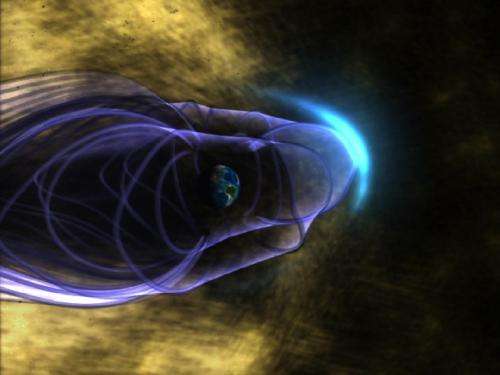Electric Moon jolts the solar wind

(ĖĮÐÄĘÓÆĩ) -- With the Moon as the most prominent object in the night sky and a major source of an invisible pull that creates ocean tides, many ancient cultures thought it could also affect our health or state of mind â the word âlunacyâ has its origin in this belief. Now, a powerful combination of spacecraft and computer simulations is revealing that the Moon does indeed have a far-reaching, invisible influence â not on us, but on the Sun, or more specifically, the solar wind.
The solar wind is a thin stream of electrically conducting gas called plasma thatâs constantly blown off the surface of the Sun in all directions at around a million miles per hour. When a particularly fast, dense or turbulent solar wind strikes Earthâs magnetic field, it can generate magnetic and radiation storms that are capable of disrupting satellites, power grids, and communication systems. The magnetic âbubbleâ surrounding Earth also pushes back on the solar wind, creating a bow shock tens of thousands of miles across over the day side of Earth where the solar wind slams into the magnetic field and abruptly slows from supersonic to subsonic speed.
Unlike Earth, the Moon is not surrounded by a global magnetic field. âIt was thought that the solar wind crashes into the lunar surface without any warning or âpush backâ on the solar wind,â says Dr. Andrew Poppe of the University of California, Berkeley. Recently, however, an international fleet of lunar-orbiting spacecraft has detected signs of the Moonâs presence âupstreamâ in the solar wind. âWeâve seen electron beams and ion fountains over the Moonâs day side,â says Dr. Jasper Halekas, also of the University of California, Berkeley.

These phenomena have been seen as far as 10,000 kilometers (6,214 miles) above the Moon and generate a kind of turbulence in the solar wind ahead of the Moon, causing subtle changes in the solar windâs direction and density. The electron beams were first seen by NASAâs Lunar Prospector mission, while the Japanese Kaguya mission, the Chinese Changâe mission, and the Indian Chandrayaan mission all saw ion plumes at low altitudes. NASAâs ARTEMIS mission has now also seen both the electron beams and the ion plumes, plus newly identified electromagnetic and electrostatic waves in the plasma ahead of the Moon, at much greater distances from the Moon. âWith ARTEMIS, we can see the plasma ring and wiggle a bit, surprisingly far away from the Moon,â says Halekas. ARTEMIS stands for âAcceleration, Reconnection, Turbulence and Electrodynamics of the Moonâs Interaction with the Sun.â
âAn upstream turbulent region called the âforeshockâ has long been known to exist ahead of the Earthâs bow shock, but the discovery of a similar turbulent layer at the Moon is a surprise,â said Dr. William Farrell of NASAâs Goddard Space Flight Center in Greenbelt, Md. Farrell is lead of the NASA Lunar Science Instituteâs Dynamic Response of the Environment At the Moon (DREAM) team, which contributed to the research.
Computer simulations help explain these observations by showing that a complex electric field near the lunar surface is generated by sunlight and the flow of the solar wind. The simulation reveals this electric field can generate electron beams by accelerating electrons blasted from surface material by solar ultraviolet light. Also, related simulations show that when ions in the solar wind collide with ancient, âfossilâ magnetic fields in certain areas on the lunar surface, they are reflected back into space in a diffuse, fountain-shaped pattern. These ions are mostly the positively charged centers (nuclei) of hydrogen atoms, the most common element in the solar wind.
âItâs remarkable that electric and magnetic fields within just a few meters (yards) of the lunar surface can cause the turbulence we see thousands of kilometers away,â says Poppe. Other moons and asteroids in the solar system should have this turbulent layer over their day sides as well, according to the team.
âDiscovering more about this layer will enhance our understanding of the Moon and potentially other bodies because it allows information about conditions very near the surface to propagate to great distances, so a spacecraft will gain the ability to virtually explore close to these objects when itâs actually far away,â said Halekas.
More information: The research is described in a series of six papers recently published by Poppe, Halekas, and their colleagues at NASA Goddard, U.C. Berkeley, U.C. Los Angeles, and the University of Colorado at Boulder in Geophysical Research Letters and the Journal of Geophysical Research. The research was funded by NASAâs Lunar Science Institute, which is managed at NASAâs Ames Research Center, Moffett Field, Calif., and oversees the DREAM lunar science center.
Provided by JPL/NASA




















